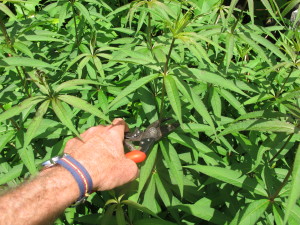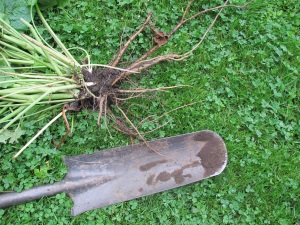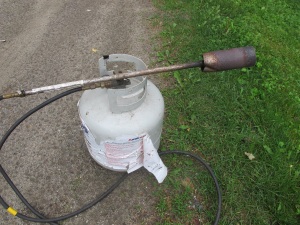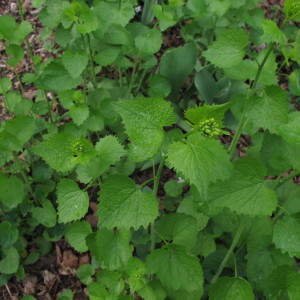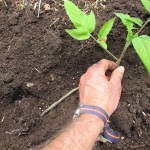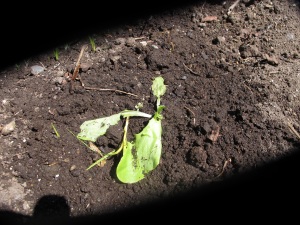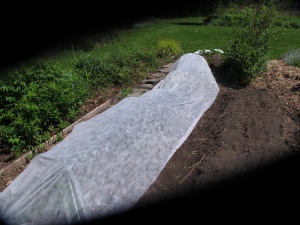Pinching? This Isn’t Kindergarten!
I was presenting at an outdoor gardening event recently when a woman walked by wearing a tee shirt that said, “No Pinching!” Maybe she had young kids, or was a kindergarten teacher. Clearly she was not an experienced gardener. Pinching plants is good, and now is the time to do it.
Let’s start with fruit trees. Many apple trees are loaded with small fruit now. Often there are 5 or more fruits together, especially at the tips of branches. If you pick off all but one or two fruits now, they will grow to a nice size. If you leave all the fruit on the tree, each fruit will be smaller. Not only that, you can often see what fruit is already damaged by insects and disease; it is smaller, and discolored. Removing that fruit will help the fruit you leave to be healthier. And eventually, you have to pick all the fruit anyway. It’s easier to do it now than in the fall. Leave the biggest, best looking fruit.
To thin fruit now, hold the cluster of small fruits in one hand, and pinch them off with the other. Holding the cluster helps to avoid breaking off the fruit spur and all the fruit on it. You can use pruning shears, but it is faster just to pinch (or pull) off the fruit. Don’t throw the fruit on the ground; it may be diseased or harbor insect pests, so you want to get rid of it. Come with plastic buckets and place them strategically around the tree as you work.
Work your way up the branch. Leave an apple or two every 8 inches. Michael Phillips, the author of two excellent books on growing organic apples, explains The Apple Grower: A Guide for in the Organic Orchardist (Chelsea Green Publishing, $40) that it is good to take all apples on alternating fruit spurs. This promotes a good harvest every year instead of a big harvest every other year, which is common on some varieties of trees. And remember, as you lament pulling off potential pies, that there is a limit to how many apples most of us can use.
I recently pinched off a bucket of blossoms from that terrible invasive weed known as goutweed or Bishops’s weed (Aegopodium podagraria). I have come to accept that I will never rid myself of this noxious pest, but I do believe I can limit its spread. It spreads quickly by root, which I limit with a lawnmower and some pulling. Seeds? From a reading of the literature, that they do not appear to be a primary means of dispersal. Still, in 15 minutes I can rid myself of the seeds, so I do. No point in taking chances.
When picking the goutweed flower heads, I ended up using my pruners, because with each flower, there is usually a lower, secondary flower cluster that is still developing under the shade of the leaves. I want to get both, so I reach down and snip off the stem lower down. Instead of tossing the flowers in the compost, I put them in the household trash that will go to the incinerator. A fitting demise for a devilish plant.
Annual flowers are coming in to bloom now, and pinching off spent flowers is important. I have some nice purple verbena growing in a window box by the front door. I often pause for a few moments and look at it to see if there are spent flowers. There always are, and I pinch them off. This stimulates the plant to set new buds. After all, it wants to make babies – and if an herbivore or a tidy gardener has removed its seeds, it needs to make more, starting with new flowers.
Not all annuals need to have their flowers pinched off. Some are called “self-cleaning”. They drop their flowers once they have finished blooming. Impatiens, begonias, and Euphorbias like ‘Diamond Frost’ are self-cleaning. Those that do need deadheading include annual bachelor buttons, gazanias, geraniums, marigolds, osteospurmums, pansies, pincushion flowers, salvias, snapdragons, sunflowers, verbenas and zinnias.
Another June task is to pinch or cut back tall summer- of fall-blooming perennials that you wish would stay shorter or bloom later. But you must do this now, or soon. It is fine to cut back these perennials when they are starting to form buds. The stems that you cut back – I recommend cutting off 4 to 6 inches – will have smaller flowers and often instead of 1 flower per stem, may have multiple blossoms.
I have already cut back my Culver’s root (Veronicastrum virginicum) and some of my bee balm (Monarda didyma). Both respond well to it. They bloom at a shorter height. My Culver’s root, if left alone, will often flop over –it can reach 4 to 5 feet in height. I cut back stems in a ring around the perimeter of the big clump, leaving just a few at full height in the middle. The lower stems help support the taller ones, and they bloom at different times.
There is a wonderful book by Tracy DiSabato-Aust, The Well-Tended Perennial Garden (Timber Press, $34.95) that nicely explains cutting back, and lists those perennials that respond well to it – and those that do not. She recommends cutting back asters, purple cone flower, Joe Pye weed, helenium, phlox, rudbekias and more.
So go ahead and pinch something. You’ll see it’s good –despite what you may have learned in kindergarten.
Henry is the author of 4 gardening books, and a children’s chapter book about a boy and a cougar, Wobar and the Quest for the Magic Calumet. His web site is www.Gardening-Guy.com.
Weeding
I love weeding. It creates order out of chaos, something I have come to appreciate. An un-weeded flower bed is full of distractions. My brain is constantly instant messaging me: “See that dandelion? You should pull it”. The weeds distract me from the beauty of the flowers and the texture and color of the leaves. I feel better as soon as I get my weeds pulled. That said, I still have weeds. Maybe I need to retire from writing a column!
Weeding also makes my plants thrive. Weeds compete with vegetables and flowers for sunshine, moisture, nitrogen and micro-nutrients. In the early spring when my perennials are just waking up, I am very careful not to yank their little green sprouts, thinking they are weeds. In fact, I often let some of my weeding go until late May or even mid-June when everything is obvious.
Dandelions, weeds that I don’t mind in the lawn, can get a bit rambunctious in the garden beds, and I pull them without compunction. Because they have a deep taproot, they are best pulled when the soil is moist. I use a long narrow shovel, one sold as a “drain spade” to loosen the soil down 12 to 16 inches. This spade is just 6 inches wide but the blade is16 inches long. I push the blade deep into the soil, pull back a little, then push it forward, and then slowly pull out the weed, the slower the better.
Sometimes I see a little dandelion and just grab it and pull – only to have the top break off while the roots remain. Whenever you leave dandelion roots, or even fragments of root, the plant will grow back.
Burdock and thistles also have tap roots, some going down very deep. The older the weed, the deeper the root. I’ve pulled mature burdock plants with roots nearly two feet deep. This is only possible when the soil is moist.
It’s really critical, especially for any weed that produces lots of seeds, that you not let them flower. If you don’t have time to dig them out, at least snip off the flowers. Many weeds have green flowers, and some will produce seeds even after being pulled if they have already formed flowers. I don’t throw noxious weeds, things like goutweed, in the compost pile for fear they will grow and spread – or leave seeds.
My favorite weeding tool is the CobraHead weeder (www.CobraHead.com). This is shaped like a tine on farmer’s cultivator – or a bent steel finger. I like it because it is narrow in profile and curved in a way that allows me to easily get the blade under the roots of a weed. I pull from below with the CobraHead while pulling the tops from above. I drag it through the soil in a bed after weeding and am always surprised by now many fragments of root it brings to the surface. I can use it with one hand or two. I use it for loosening the soil while planting, too. It is neither right- or left-handed, it is lightweight, and the handle is made from re-cycled plastic.
The CobraHead is great for teasing out long roots, too. I once pulled out a root 39 inches long in one piece, just gently loosening with the tool while tugging on the weed. That root was from a Queen of the Prairie (Filipendula rubra), a lovely pink-flowered perennial thug. It’s great for teasing out roots of invasive grasses.
Another great weeding tool is a favorite of my comic hero, Calvin, of Calvin and Hobbes. I refer to my flame thrower. It is technically a flame weeder, but Calvin and I refer to it as a flame thrower. It’s a metal wand on a 10-foot rubber hose attached to a propane tank normally used for gas grills. Light it, and it sends a flame out of the nozzle that will turn any weed crispy in an instant.
I often use my flame weeder on freshly turned soil. I let weed seeds germinate for a week or more, then burn them off before I plant. I try not to disturb the flamed soil when planting, as seeds that have been buried deeply will not germinate, but those on the surface, or near the surface will. Many weeds have what I call a photo-trigger. No light? They won’t germinate. Or I will flame, then plant seeds, then flame again before my carrots are up. Available from Johnny’s Selected Seeds or Fedco Seeds.
One of the worst weeds in the world is garlic mustard. Not only will it outcompete other plants in the understory, it can grow in full sun to full shade, and can produce many tens of thousands of seeds per square yard. Garlic mustard is also allelopathic, meaning that it produces chemicals that inhibit the growth of other plants and mycorrhizal fungi needed for healthy tree growth and tree seedling survival.
A friend last year hired a guy to pull all the garlic mustard under her trees and shrubs. It pulls easily, and he quickly filled wheelbarrows full of mature plants. But this year there were thousands of tiny garlic mustard seedlings popping up all over, even in the bark mulch he had put down. I lent him my flame weeder, and in no time he had burned off the small plants.
Many weeds can be deterred by a good thick layer of mulch. Seeds don’t germinate, or seedlings can’t push through the mulch, particularly if you lay down 4-6 sheets newspaper before mulching. Other, aggressive weeds will. Mature Japanese knotweed roots have been said to push through an asphalt driveway! Still, most garden weeds are really just enthusiastic plants that want to be your friends! My practice is to pull weeds every day, and that way I hope to finally beat them. Hah!
Henry is a garden writer, public speaker and garden consultant. He lives in Cornish Flat, NH. You may reach him at henry.homeyer@comcast.net.
June in the Vegetable Garden
I know gardeners who rush to get their veggies in the ground, starting spinach and peas in April, carrots, potatoes and more by mid-May and then tomatoes and all the rest by Memorial Day weekend. Not me. I’m just planting many things. Sure, my peas, planted in May, are about a foot tall. And all my root crops – beets, carrots, kohlrabi, leeks, onions and rutabaga are up and looking good. Let’s look at some other vegetables.
Organic corn seeds, the type I buy, are not treated with fungicides and so they might rot if planted in wet, cool ground – and that describes the type of soil I have right now. So here’s what I do: I plant them in “plug trays”. Mine are plastic trays with 98 growing compartments per flat, each a bit deeper than the standard 6-packs I use for starting veggies in flats. I fill the holes with a 50-50 mix of potting soil and fine compost and plant one seed in each.
Corn takes 10-14 days to germinate in cold, wet soil. Last year, the first time I grew corn in many years, my corn germinated on a heat mat in 3 days! I let it grow for a week or so, allowing the roots to fill the soil compartments of my plug trays and develop true leaves.
Then, on a hot sunny day in mid-June, I planted the corn seedlings in the field. It was quick work for two people: I crawled along on my hands and knees, planting corn every 8 inches; my partner, Cindy slipped the plants out of the flat and handed them to me. We allowed 30-36 inches between rows. If space is a constraint, you can plant rows 24 inches apart, but the ears will be smaller. In order to get good pollination, you must plant in blocks with at least 4 rows.
Crows are the bane of corn growers. They love the corn seeds that have just germinated and have some small leaves. By planting good-sized plants, the corn is less vulnerable. It only takes a day or so for the roots to develop the strength to resist crows, and the germinated seed is long gone.
A wise gardener who direct-seeds her corn told me that she sprinkles fresh grass clippings around her corn when it first germinates. The greenery disguises the seedlings, fooling the crows. She does that twice, allowing the corn to be well settled in. Slick!
June 10 is my usual day for planting tomatoes, though I’ve planted later, and the plants catch up quickly. I plant tomatoes deeply, or sideways. That way the long stems become shorter and less floppy, and the buried stems develop roots, providing more roots to absorb water and nutrients.
To plant sideways, dig a hole for the rootball and a trench for 6 inches (or more) of stem. Pinch off all the lower leaves and branches, just leaving the top leaves. Cover the rootball and stem, and turn the top up. The series of photos below shows each step.
This year I am not adding any fertilizer in the planting hole. Usually I add some bagged, slow-release organic fertilizer in each hole. But reading Carol Deppe’s book, The Tao of Vegetable Gardening, last winter convinced me that too much fertility encourages tall plants but less fruit. Maybe I’ll do some each way and see for myself.
The vine crops – cukes, zukes, winter squash and pumpkins – would be badly munched by striped cucumber beetles unless I take preventive actions. The dastardly beetles and eat the new cotyledon leaves in a single night! So now I start them in small pots indoors, and let them develop foot-long vines before I put them out.
I also cover my vine crops with Reemay or row cover when I plant them to keep those beetles off. I don’t bother using wire hoops to keep the Reemay off the plants, I just lay it down and pin the edges to keep it from blowing away. But I have to remove it when the plants flower, as they are insect pollinated. By then the plants are big enough to survive. Row covers are good for keeping flea beetles off broccoli, too.
Potatoes can be planted in May – or now. I plant in June, in part, because my soil is near a stream and is colder and wetter than many other gardens around. But I also do it so that the Colorado potato beetle will go to my neighbors’ potatoes instead of mine (sorry, Lois). That’s right, they will be munching away on the neighbor’s potatoes before mine even go in the soil.
I plant lots of beans, in part because they freeze so well that I can store them and eat them all year. I plant beans in mid-June when the soil is plenty warm – 65 degrees or more, and when nights are warm, too.
Nights in the 40’s or low 50’s are very discouraging for warm-season crops like peppers, beans and tomatoes. Egggplants hate chilly nights. You can place a dark-colored rock the size of a melon near each eggplant, and it will soak up heat during the day and kick it back at night. I do that for peppers sometimes, too.
Gardening is a dance I do with the weather, the birds and the bugs. Sometimes I get great harvests, other times I do not. Still, I consider myself blessed to have a plot of good soil, an amenable climate, and the good health to pull the weeds! I wish the same for you!
You may e-mail questions to Henry at henry.homeyer@comcast.net. His website is www.Gardening-Guy.com. His book, The New Hampshire Gardener’s Companion, is just out in an expanded 2nd edition.
Season Blues
Thank heavens we finally got some rain. I had less than half an inch in the first 29 days of May. If my plants were puppies, they’d have done a lot of whimpering during that last hot week of the month. They’d have been begging for water, complaining of neglect. There are things we can do to help our plants through hot spells, and it makes sense to think about them now, as summer begins.
Just as EMT’s do at an accident scene, sometimes it’s necessary to perform triage in the garden. Pick the plant that is suffering the most and water it. In principle, I don’t believe that established perennials should need to be watered. Put the right plant in the right place and it should thrive. But after a month without rain, watering may be needed and if you have lots of plants, you need to decide where to begin.
I begin with newly planted things that are stressed. These are the ones that have limp leaves, or, worse yet, are flopping over. The very act of planting disturbs roots and the fine root hairs that suck up water from the earth. If you move a perennial or small tree, you have certainly cut off some of the roots – they extend long distances and you cannot see the finest of their roots. Even a shrub purchased at a nursery and carefully planted will take weeks to settle in. Some shrubs even need extra water in year two after planting. And roses do best with more water than most.
How you water is important, too. I don’t water with an overhead sprinkler. They water everything, including walkways and weeds. I use a handheld device called a watering wand that allows me to get water where I want it – at ground level. The 36-inch wand attaches to the hose and has a nice “rose” on the end that turns a potentially torrential deluge into a strong but gentle shower. There are lots of brands, but I find that “Dramm” brand devices work perfectly every time – and are worth the extra cost. I have a thumb switch on the wand that allows me to turn it off and on, and to regulate the flow.
My lettuce, started indoors by seed and hardened off well, wilted badly after planting last week. I planted at dusk and watered it well, but the next day hit 90 degrees. When I saw it gasping for breath at noon, I gave it a dose of a commercial remedy I use for transplant shock. It is called SuperThrive (all one word) and is made from seaweed extract and plant hormones. A capful in a watering can is all it takes, and it does help.
If you’ve just planted veggies that are suffering from the heat and dryness, think about providing some shade. I covered my lettuce with row cover (also called by trademarked names, Reemay or Agribon). I have wire hoops that I pushed into the soil, then draped this thin layer of synthetic fabric over the hoops and pinned down the edges with landscape staples. It protects the plants from hot, drying winds and reduces the intensity of the sunshine slightly. Air and moisture passes through this fabric, which I also use at times to keep insects off plants.
I also planted a small clematis vine last week, and provided some temporary sun protection simply by simply placing a couple of buckets near it to provide shade in the hottest part of the afternoon. Later I will plant a medium-height flower in front of the clematis to keep the roots shaded and cool, which they like. I’ve been known to use sheets of cardboard to provide shade, or to use a beach umbrella at planting time.
Soils make a big difference in watering needs. Sandy soils dry out and drain fast. Good loam holds moisture nicely. Clay soils can hold too much water, rotting roots in wet times. Adding compost to any soil at planting times helps to achieve that desired “moist, well-drained soil” that gardening articles suggest.
Mulch is good for holding in moisture and discouraging weeds. In the vegetable garden I put down newspaper (4 to 6 sheets thick) covered with straw, hay or leaves. Around bigger plants like tomatoes I leave some open, un-mulched space around the stem. That allows a quick rain or a visit with my watering wand to get moisture to the roots more easily.
In flower gardens I sometimes use finely ground hemlock bark that I buy by the pickup-truck load. Some gardeners like to install landscape fabric under the mulch, but I rarely do that. I find that the worst of the weeds can get through anyway, and their roots become entangled with the fabric, making it tough to remove them entirely.
Chopped autumn leaves are great mulch for gardens. They help to keep down weeds, provide organic matter to soil microorganisms, and hold in moisture. Earthworms love leaves. One gardening friend bags all her leaves after running over them with a lawnmower in September, and stores them for use now.
Weeds, well known garden villains, are not just competing with your onions and lettuce for sun and soil nutrients, they also want the water – especially in dry times. Get your garden off to a good early start this summer by weeding for 15 minutes a day – minimum. I have a lot of garden space and try to spend an hour a day pulling weeds. Once weeds bloom and spread their seeds, the work will multiply exponentially, so do it now and have less work later.
Henry Homeyer is gardening educator and author of 4 gardening books. His website is www.Gardening-Guy.com. You may e-mail questions or comments at henry.homeyer@comcast.net.




